Saw Palmetto in Commerce
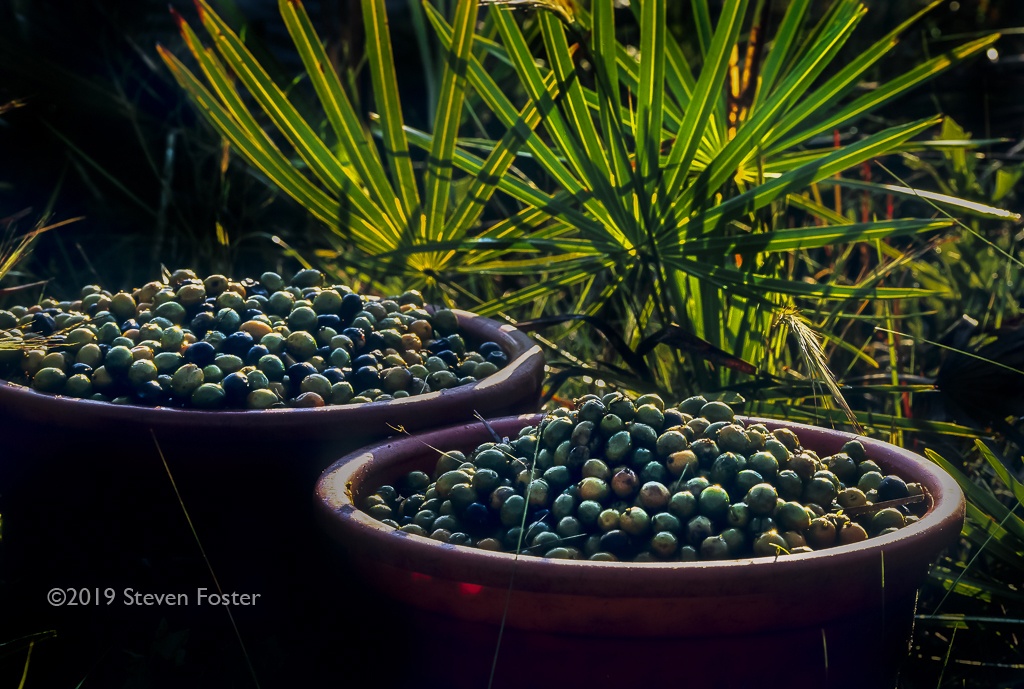
Part 1: Revelations from European Contact to 1990
This is part 1 of a 2-part series. See also part 2.
By Steven Foster
Saw palmetto is a conservation and sustainability conundrum. The question of “where does the supply of saw palmetto berries come from?” is easily answered. Nearly the entire commercial supply of saw palmetto fruit (Serenoa repens, Arecaceae), or berries as they are called in the herbal trade, is wild-harvested primarily in Florida and to a lesser extent, southeastern Georgia. The question, “where will saw palmetto berries come from in the future, and is their supply sustainable?” is inextricably woven into differing human views of the natural world, and the overriding impact of observable climate disruption in a single human lifetime. Climate disruption leading to hotter drier soils, periods of greater precipitation intensity, and rising sea levels are long-term threats; coupled with high demand, and frequent supply shortages. These factors combine to make saw palmetto berries’ future sustainability tenuous.
See Adulteration of Saw Palmetto for information on current markets, supplies, and adulteration of saw palmetto. And see the Toil of Harvest for an account of harvesting saw palmetto.
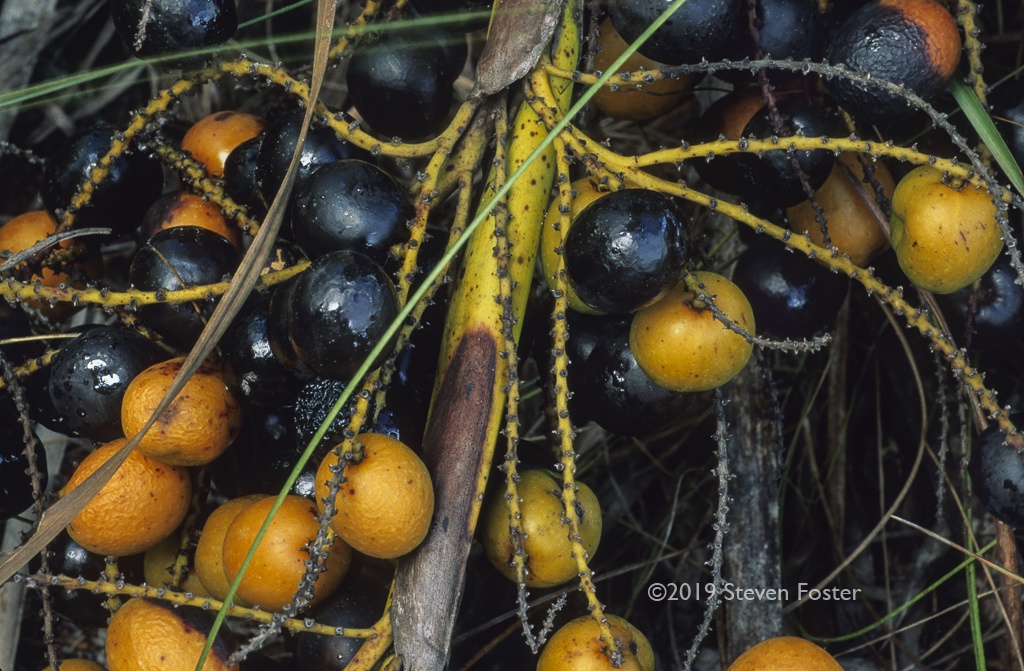
Saw palmetto berries “on the vine.” Photo by Steven Foster.
In this the first installment of a two part series, we will begin to explore the experience of human interaction with saw palmetto berries as food and medicine from the time of European contact to the entry of saw palmetto products to consumer mass markets in Europe and North America in the early 1990s. Part two of the series will focus on the saw palmetto conservation conundrum from the 1990s to the present time.
Where it grows
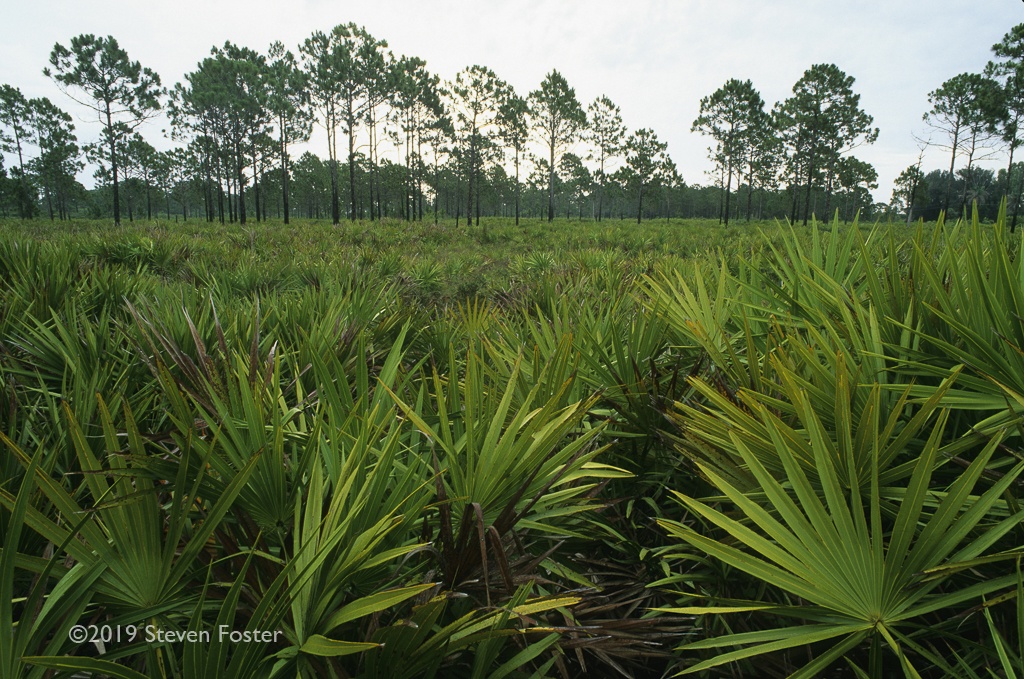
Typical saw palmetto pine scrub habitat in south-central Florida. Photo by Steven Foster.
Sometimes called “sabal,” (based on a now obsolete botanical name Sabal serrulata) saw palmetto is a three- to- nine-foot (or more) tall shrubby palm family member found exclusively in the southeastern United States from the lower coastal plain in southeastern South Carolina and Georgia, to Florida, west to coastal Alabama with isolated populations along the Mississippi coast and a few scattered populations recorded in Tammany Parish, Louisiana. It is most common in Florida, where it is found in hundreds-of-thousands of acres, especially in the eastern, central and southern parts of the state.[1]
Endemic to the southeastern United States, saw palmetto is the most abundant native palm in North America. It is adapted to a variety of habitats, thriving in sandy soils, often in dry conditions. In short it is a ubiquitous and common plant in many of Florida’s terrestrial ecosystems.[2]
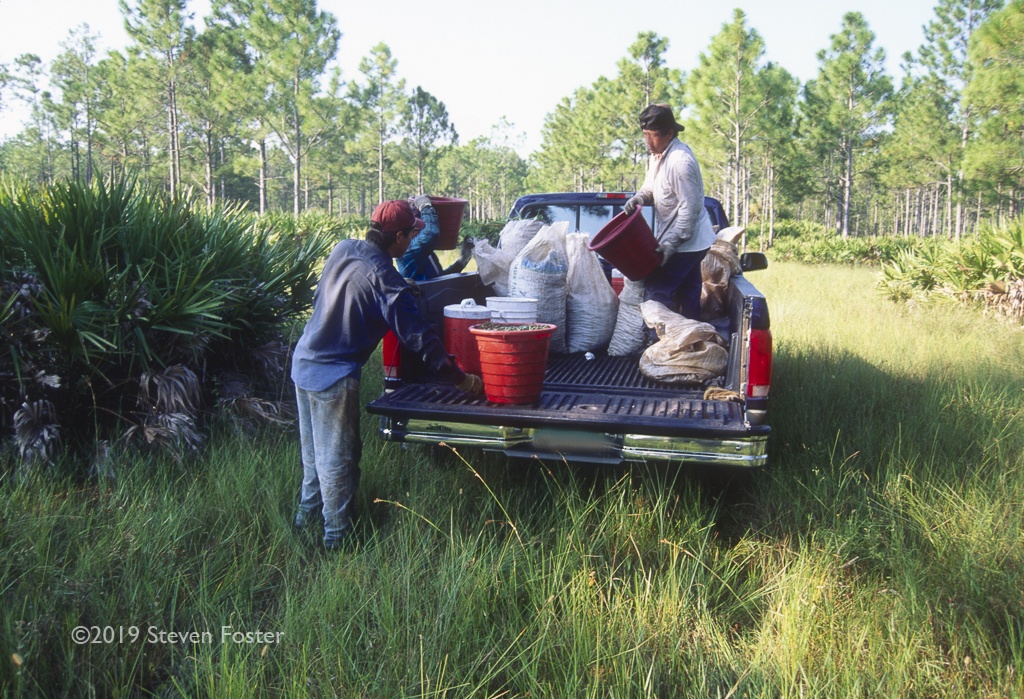
Loading a pick-up with saw palmetto berries. Photo by Steven Foster.
In 1998 Bennet and Hicklin, quoting a 1947 paper report about 10% percent of Florida’s land surface (1.42 million hectares or 3.5 million acres) was covered with saw palmetto. Conversion of saw palmetto scrub into citrus plantations, rangeland, surface water drainage, along with suburban and urban development have greatly reduced saw palmetto’s natural habitat.[3]
Saw Palmetto “The Plant from Hell”
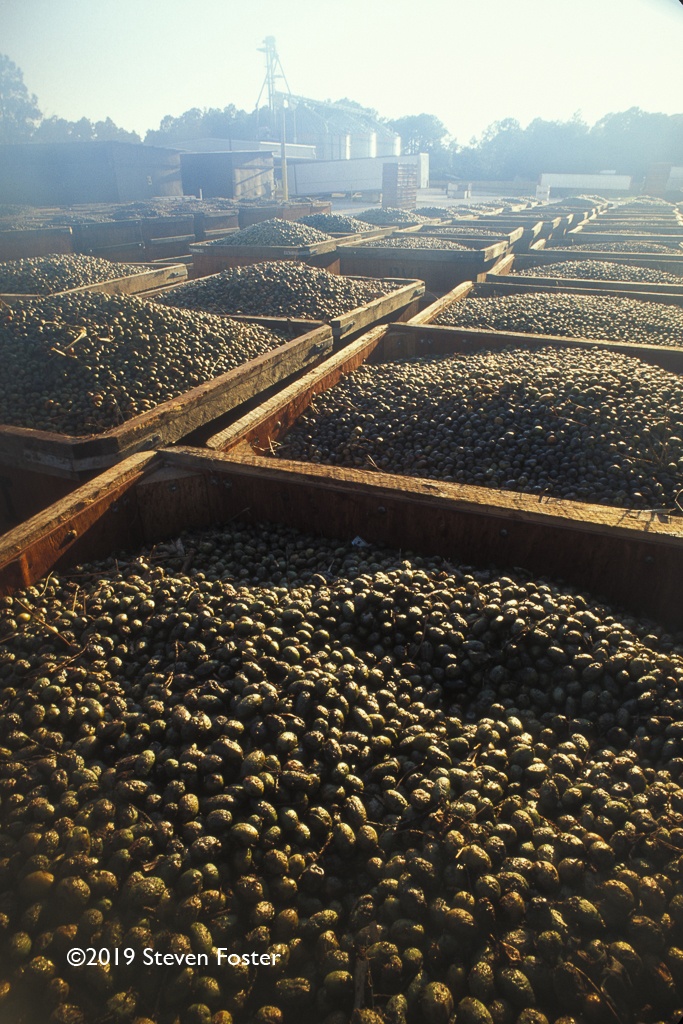
A day’s intake of fresh saw palmetto berries at Plantation Botanicals, Inc., Felda, Florida (September, 1996), to be transferred to driers before day’s end. Note the humidity in the air. Photo by Steven Foster.
In some land use management schemes saw palmetto was (is) considered a nuisance plant in the face of development, competing with more desirable native species (for farm animals), blocks power pole and utility access, reduces livestock forage, and hinders livestock ranching operations in general. In Florida, some call it “the plant from hell.” Developers bulldoze thousands of acres of saw palmetto each year. “For these reasons, control of this common native plant is often necessary,” according to authors of a 2012 Institute of Food and Agricultural Sciences (IFAS) University of Florida Extension publication. This publication provides details on chemical control using the herbicide metsulfuron (and others) for spot and broadcast application for control of saw palmetto.[4]
Another IFAS extension publication provides details on how to mechanically control saw palmetto with roller shoppers, brush cutters and web plows. Since cattle were introduced in 1521, 7.6 million acres of Florida wildlands have become livestock rangeland.[5] In the 1950s, mixtures of various herbicides such as equal parts of 2,4,5-T and 2,4-D were used to control saw palmetto.[6]
A Foundational Species
Saw palmetto is a foundational species in many of its varied habitats. Individual plants were once thought to be upwards of 700 years old, through recent genetic studies reveal that clonal networks of 10,000-year-old genetically identical individuals may be common.[7]
Saw palmetto primarily propagates by vegetative sprouts. It is resilient to and thrives on fire disturbance, with fire being a critical component to stimulating reproduction of stem tips. It is adaptable to seasonally arid environments in nutrient-poor acidic soils. Saw palmetto is remarkably adapted to photosynthesis efficiency in both low light conditions (as an understory shrub) and in full sun. It has extremely slow-growing seedlings, and human-caused disturbance to its native habitats can have long-lasting impact. The greatest threat to saw palmetto is habitat loss due to human development.[8]
Wildlife Food
Many observers in last 500 years have noted the importance of saw palmetto fruits as both forage and cover for wildlife including the Florida black bear, Florida’s eastern most populations of the North American panther, along with raccoons, rats, twenty other wild mammal species, over 100 bird species, twenty-five amphibians, sixty-one reptiles and innumerable insect species. As a keystone species in Florida’s varied habitats, the fruits are characterized as fueling the engine of Florida’s wildlife communities.[9]
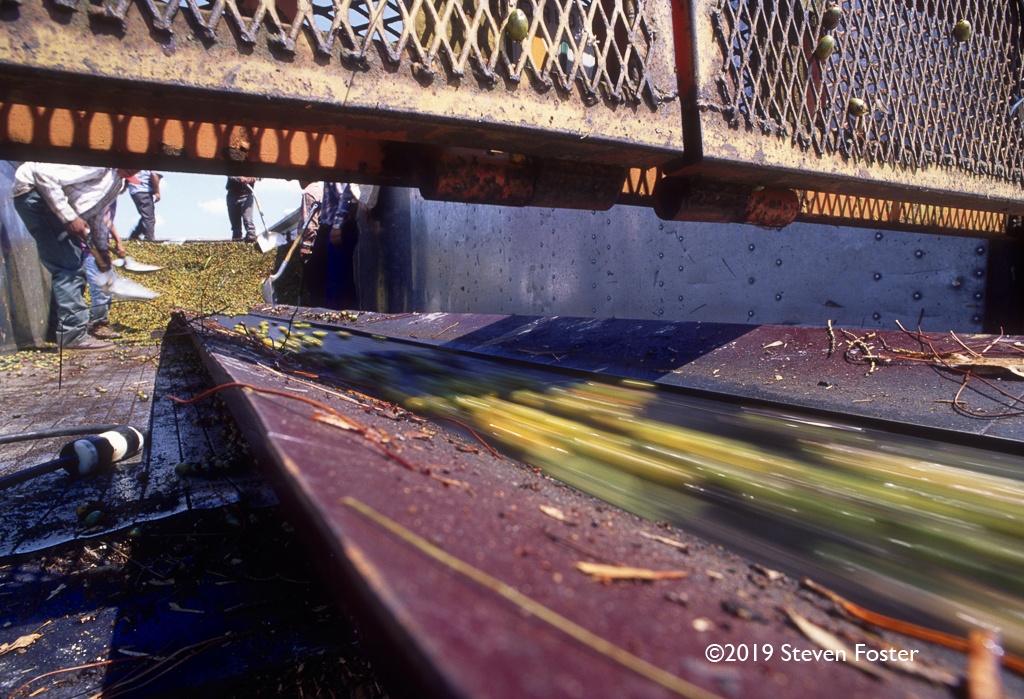
Unloading saw palmetto berries from a truck to a conveyor belt. Photo by Steven Foster.
Late nineteenth century interest in saw palmetto as medicine was in part stimulated by observations on value as food for Florida wildlife. In his 1898 book on saw palmetto, E. M. Hale, M.D., quoting J. B, Read (1879), without attribution, “Several years ago, while on a hunting trip through the wilds of Florida, my attention was drawn to the great fattening properties of the berries, and peculiar quality of the fat of the animals that feed on them. Most animals in the palmetto region are very fond of the fruit . . . . as the palmetto berries begin to ripen the animals improve rapidly and in a few weeks have acquired an enormous quantity of fat. . .The berries, when dropped into water are seized and eaten with avidity by the fishes. Even water fowl and other birds frequently acquire a taste for the berries and eat them freely.”[10]
Overlooked Human Food
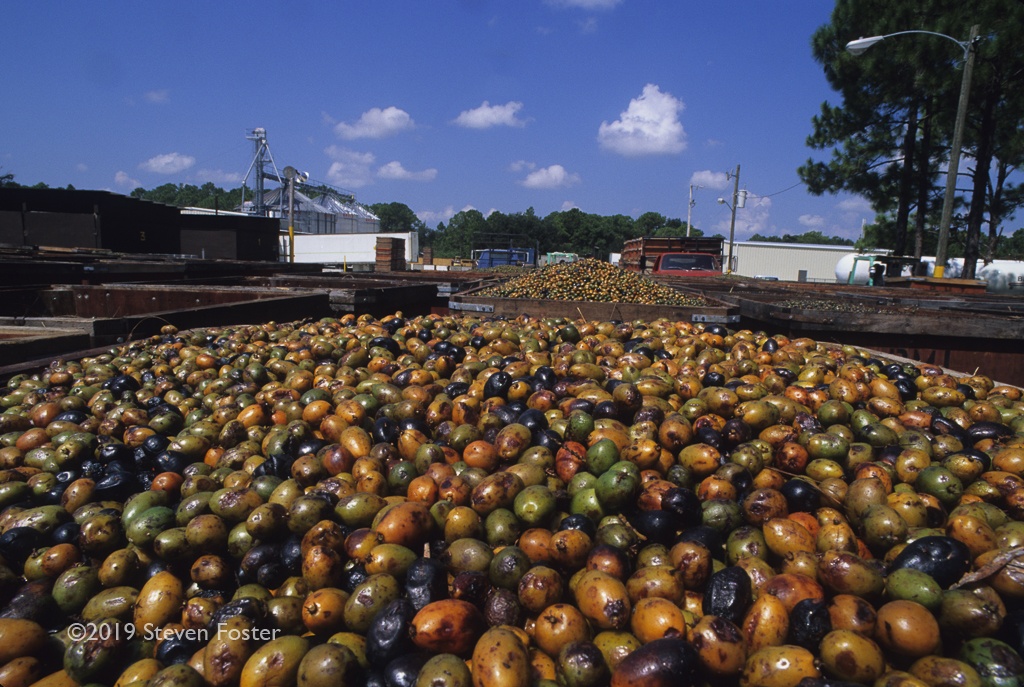
Fresh saw palmetto berries ready to haul to a dryer. Photo by Steven Foster.
Since the period of European anthropogenic alien invasion and subsequent environment disturbance to what is now the Southeastern United States, humans have exhibited a love-hate relationship with saw palmetto. Native groups throughout the plant’s range consumed the fruit as a staple food. In 1575 Spanish explorer Hernando Descalante Fontaneda was the first to record the use of the berries as food by indigenous groups in Florida. Cultures now extinct, existing at the time of first European contact in 1513, including the Calusa, Tequesta, Mayamis, Jaega or Job, and Ais, collectively known as the “Glade Indians” of southern Florida were observed to consume saw palmetto fruits. The Ticuma and Apalachee ate fresh berries. The Choctaw were observed drying the fruits for winter consumption. The Alabama, Creek, and Miccosukees as well as the Seminoles consumed the fruits.[11, 12]
Pharmacist John Uri Lloyd in a footnote on saw palmetto writes “Since the saw palmetto berries contain much fixed oil it might also be inferred that the food side of the subject should not be overlooked.” He also observed that people became interested in the berries following its apparent effect on animals, investigations by physicians followed, then it was introduced into medical practice as a new remedy, and became one of the most important native remedial plants harvested from the South in the late nineteenth and early twentieth centuries.[13] Earlier in 1884-85, J.U. and C.G. Lloyd noted use as a substitute for cod liver oil, and that saw palmetto oil was then offered for sale by Solomons & Co. of Savannah, Georgia.[14]
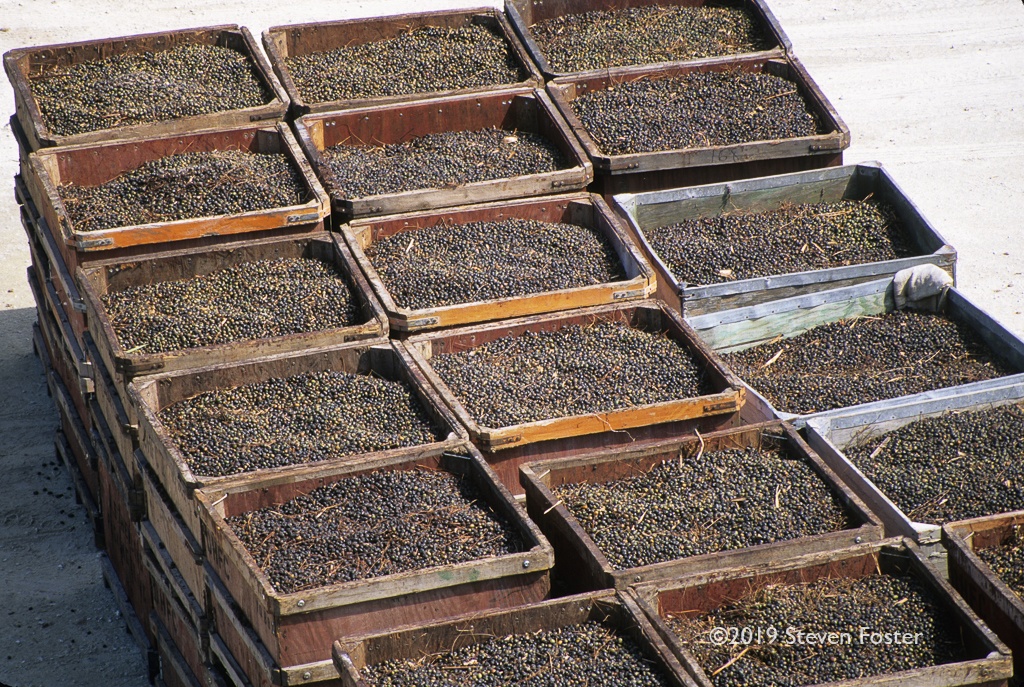
Freshly harvested saw palmetto berries. Photo by Steven Foster.

Title page of Jonathan Dickenson’s harrowing account of shipwrecked Quakers with description of surviving on palmetto berries.
In 1791, William Bartram who encountered the plant in the 1770s, is the first to botanically describe the plant in the modern sense and coined the phrase “saw palmetto.” He notes “this fruit is of the form and size of dates, and is delicious and nourishing food.”[15] In a 1768 manuscript of William Bartram discovered in 1847 and published in 1853, he describes the taste of the fruits as “a little bitterish and stinging on the palate, at first using it, but soon become familiar and desirable.”[16]
Precolonial and colonial works such as Bartram’s Travels and other accounts of faraway lands served as the early American equivalent of reality TV. While native groups and early Western naturalists include saw palmetto fruits among important wild foods of Florida, one famous and often quoted travel account recorded great disdain for their flavor. Jonathan Dickenson’s sensationalized journal of a shipwreck on the Florida coast in 1696, first published in Philadelphia in 1699, and reprinted in numerous editions in at least three languages, up until 1869, is among the most famous of all traveler captivity tracts from the seventeenth century. The book becomes a page-turner with the title itself: “God’s Protecting Providence, Man’s Surest Help and Defence in time of the greatest difficulty, and most eminent danger. Evidenced in the remarkable deliverance of Robert Barrow with divers other Persons, from the devouring waves of the sea; amongst which they suffered Shipwrack; And also, from the cruel Devouring Jaws of the Inhumane Canibals of Florida.”
Dickenson sullied saw palmetto’s future as food, as described in the 1700 London edition:
“At first their Sorrows were so great, and their Alarms so many, they could not eat; afterwards their Diet so uncouth, they could not away with it; until, at length, Hunger bad so far prevailed over them, that they could eat with an Appetite the Palmetto-Berries; the taste whereof was once irksome, and ready to take away their Breath [at first] . . . they gave us some of their Berries to Eat: We tasted them, but not one amongst us could suffer them to stay in our Mouths, for we could compare the taste of them to nothing else, but rotten Cheese steep’d in Tobacco.”[17]
Origins of Herbal Use
Medicinal use of saw palmetto is virtually unknown until 1877 when J. R. Read, M.D. and Abraham A. Solomons (manufacturing pharmacist) introduced saw palmetto to the medical profession at an 1877 meeting of the Georgia Pharmaceutical Association. An article on its remedial powers soon appeared in an 1877 issue of the Medical Brief. Two years later in 1879, J. B. Read’s article in the April issue of the American Journal of Pharmacy introduced saw palmetto’s potential to a wider audience.[18] In the same year J. B. Read and the Solomons Company (wholesale drug manufacturers of Savannah), introduced saw palmetto products to the market. In 1879, Abraham A. Solomons also acquired patents for an “elixir of saw palmetto,” “Solomons’ Inspissated Juice of Saw Palmetto,” and “Solomons’ Saccharated Oil of Saw Palmetto.”[19] At first touted as a possible remedy for the treatment of coughs, colds, and debility, it soon gained a reputation for treatment of prostate conditions. By the 1880s and 90s various preparations were offered by Eclectic and Allopathic drug manufacturers. “Valuable in catarrh, chronic bronchitis, acute and chronic laryngitis, asthmas and whooping cough,” write the authors of Parke, Davis & Company’s Physicians Manual of Therapeutics (1900), “Recently attention has been called to a specially vitalizing action of Saw Palmetto upon the glands of the reproductive apparatus—mammae, ovaries, etc.—hence the value of the drug, in atrophy of the uterus and appendages, and of their male analogues, the prostate and testes.”[20]
Increased demand followed what might be seen today as the Victorian equivalent of Viagra.
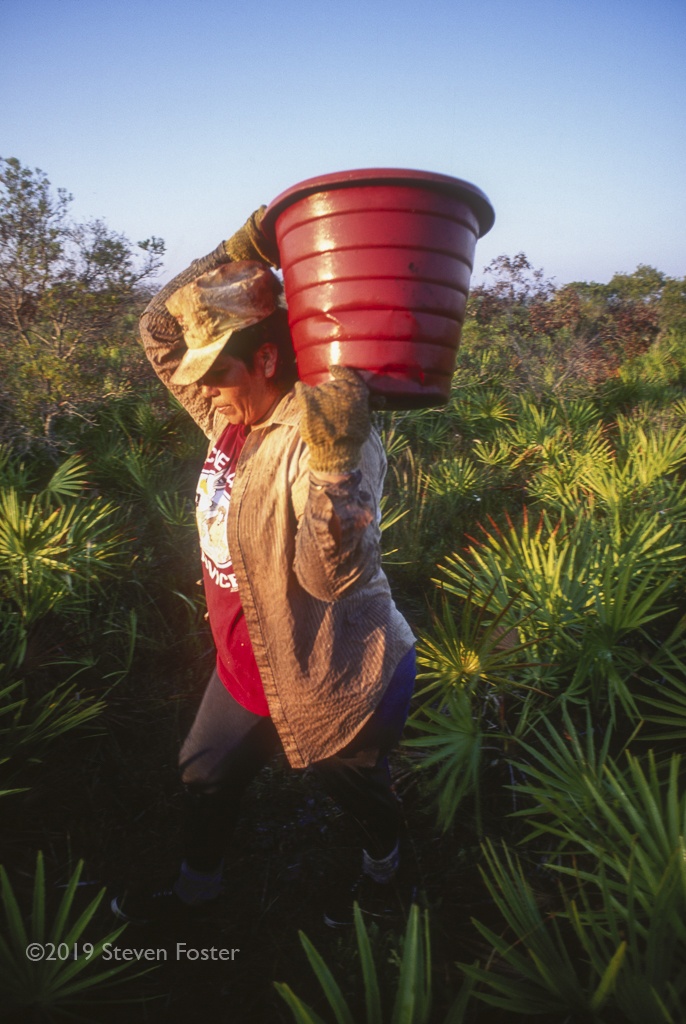
Carrying fresh saw palmetto berries to a collection point. Photo by Steven Foster.
By 1895 products were well established in the drug trade with an estimated 150 tons of annual shipments of dried berries to New York, Philadelphia and Baltimore, the largest amount (30 tons) being shipped from Ormund Beach, Volusia County, Florida. One botanical observer from that area described a vast vegetative belt of saw palmetto on Florida’s east coast, but cautioned that only one percent of the plants actually produced fruit.[21] At the same time the stem and leaves were being harvested at the rate of one-half ton to over a ton per acre. When air-dried they yielded an average of about 13 percent tannins, used to make an extract said to produce a very soft, mellow leather of a good color. In 1905, 3500 barrels of the tannin-rich leaf extract was sold.[22] In a letter to the Royal Botanical Gardens at Kew, dated February 4, 1899, Charles Sprague Sargent, the first director of Harvard University’s Arnold Arboretum, sent a sample of the dried berries for Kew’s economic botany collection, noting that by 1899, about 250 tons of the berries were being used to make extract. What does 250 tons of saw palmetto look like? Picture about two dozen twenty-foot-long railroad containers with about 10,000 lbs of dried berries each.[23]
Little trade information is available after the decline of the American market for herbal medicine following the demise of the Eclectic medical movement and herbal medicine in general by the 1930s to the herbal resurgence beginning in the 1970s. Use continued in Europe, particularly in France, Germany and Italy where saw palmetto products were a mainstay of homeopathic practice from the 1930s to the 1960s. In the 1960s, in Europe saw palmetto-based phytomedicine products emerged as standard treatments for benign prostatic hyperplasia. These products were largely prescribed by physicians and dispensed by pharmacists.
Interest increased in the early 1990s, as more scientific evidence of safety and efficacy of saw palmetto products was published, particularly in Germany, where German federal regulations at the time, required a higher level of scientific evidence for phytomedicine products which had been on the market for decades. The loss of hundreds of thousands of acres of saw palmetto habitat to rangeland (for cattle grazing), bulldozing for development, dramatic increases in demand for saw palmetto berries in the last thirty years, and potential loss of suitable environmental conditions due to shifting climate patterns, sets the stage for the second installment of this two-part story, exploring where will saw palmetto berries come from in the future and is the supply sustainable?
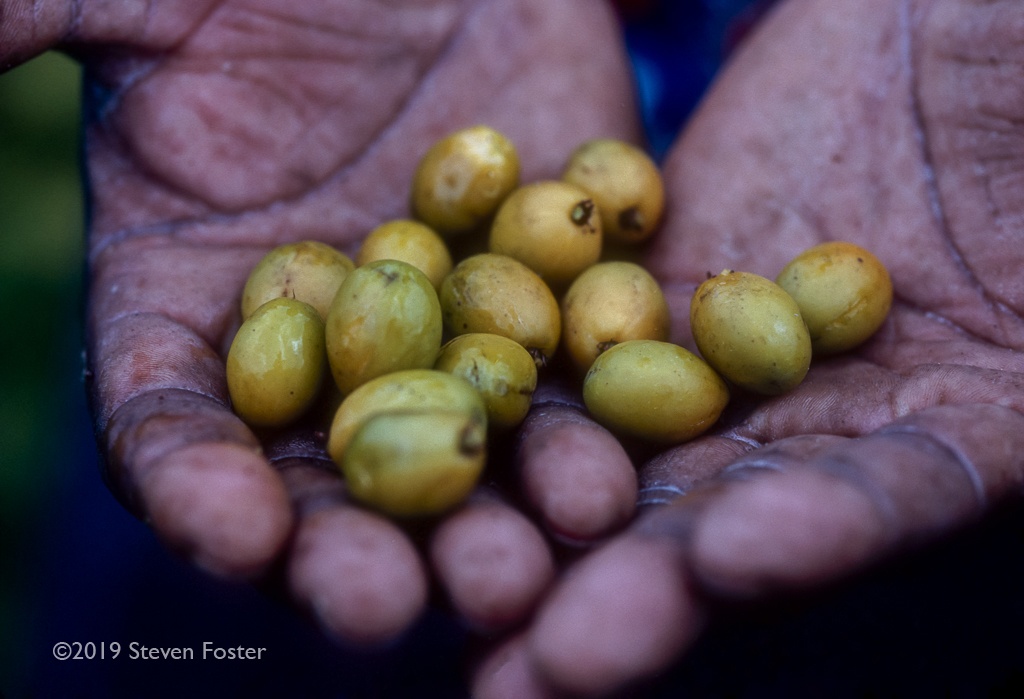
A picker’s handful of fresh saw palmetto berries. Photo by Steven Foster.
References
- Flora of North American Editorial Committee. Flora of North America North of Mexico: Magnoliophyta: Alismatidae, Arecidae, Commelinidae (in part), and Zingiberidae. 22. New York, NY: Oxford University Press; 2000: 104-05.2. Abrahamson WG. Habitat distribution and competitive neighborhood of two Florida palmettos. Bulletin of the Torrey Botanical Club. 1995;122(1):1-14.
- Abrahamson WG. Habitat distribution and competitive neighborhood of two Florida palmettos. Bulletin of the Torrey Botanical Club. 1995;122(1):1-14.
- Bennett BC, Hicklin JR. Uses of Saw Palmetto (Serenoa repens, Arecaceae) in Florida. Economic Botany. 1998;52(4):381-393.
- Fast B, Ferrell J, Seller B. Saw Palmetto Control: Individual Plant and Broadcast Application. SS-AGR-341. Gainseville, FL: U.S. Department of Agriculture, UF/IFAS Extension Service; 2012:1-3.
- Vendramini J, Kalmbacher RS, Boughton R. Managing South Florida Range for Cattle. SS-AGR-105. Gainseville, FL: U.S. Department of Agriculture, UF/IFAS Extension Service; 2006:1-12.
- Subcommittee on Chemical Control of Range Weeds for the Range Reseeding Equipment Committee. Report on Chemical Control of Range Weeds. Range Reseeding Equipment Committee Meeting; Great Falls, MT; January 27-28, 1957.
- Takahashi MK, Horner LM, Kubota T, Keller NA, Abrahamson WG. Extensive clonal spread and extreme longevity in saw palmetto, a foundation clonal plant. Mol Ecol. 2011;20(18):3730-3742.
- Abrahamson WG. Leaf traits and leaf life spans of two xeric-adapted palmettos. Am J Bot. 2007;94(8):1297-1308.
- Maehr DD, Layne HN. The Saw Palmetto. The Palmetto. 1996;(Fall):6-10, 15, 21
- Hale EM. Saw Palmetto. Philadelphia, PA: Boericke & Tafel; 1898.
- Austin DF. Florida Ethnobotany. Boca Raton, FL, London, New York, Waskington, DC: CRC Press, Society for Economic Botany, Florida Native Plant Society; 2004:617-19.
- Austin D. The Glade Indians and the Plants They Used: Ethnobotany of an Extinct Culture. The Palmetto. 1997;17(2):7-11.
- Lloyd JU. Origin and History of All the Pharmacopeial Vegetable Drugs, Chemicals, and Preparations. Cincinnati, OH: The Caxton Press; 1921:277-8.
- Lloyd JU, Lloyd CG. Drugs and Medicines of North America: Ranunculaceae. Vol. 1. Cincinnati, OH: J. U. & C. G. Lloyd; 1884-85;(appendix):10.
- Bartram W. Travels through North and South Carolina, Georgia, East and West Florida, the Cherokee country, the extensive territories of the Muscogulges or Creek confederacy, and the country of the Chactaws: containing an account of the soil and natural productions of those regions: together with observations on the manners of the Indians: embellished with copper-plates. Philadelphia: James and Johnson; 1791: xvii, 59.
- Bartram W, Squire EG, ed. Observations on the Creek and Cherokees with Prefatory and Supplementary Notes by E. G. Squier. Trans Am Ethnological Society. [1789] 1853;3(Part 1):1-81.
- Dickenson J. God’s Protecting Providence, Man’s Surest Help and Defence in time of the greatest difficulty, and most eminent danger. Evidenced in the remarkable deliverance of Robert Barrow with divers other Persons, from the devouring waves of the sea; amongst which they suffered Shiprwrack; And also, from the cruel Devouring Jaws of the Inhumane Canibals of Florida. Philadelphia and London: T. Sowle; 1700; iv, 29.
- Read JB. The Saw Palmetto (Sabal Serrulata). Am J Pharm. 1879;51(April):169-171.
- Commissioner of Patents. Annual Report of the Commissioner of Patents for the year 1879. Washington, DC: U.S. Government Printing Office; 1880.
- Anonymous. Physician’s Manual of Therapeutics. Detroit: Parke, Davis & Company; 1900: 451.
- Rusby HH, Bastedo WH, Coblentz V. The Pharmacology of Saw-Palmetto. The Alumni Journal of the College of Pharmacy of the City of New York. 1895;2(7):169-177.
- Bailey LH. Cyclopedia of Farm Crops. New York: The Macmillan Company; 1922.
- Sargent CS. Serenoa serrulata as a remedy. Bulletin of Miscellaneous Information. 1899:55-6.

Comments